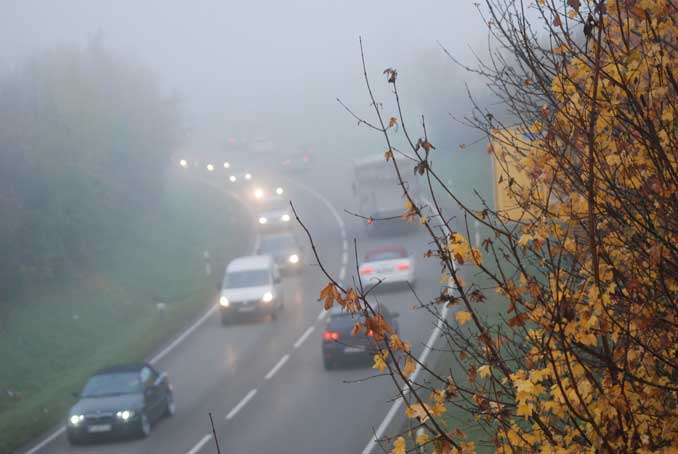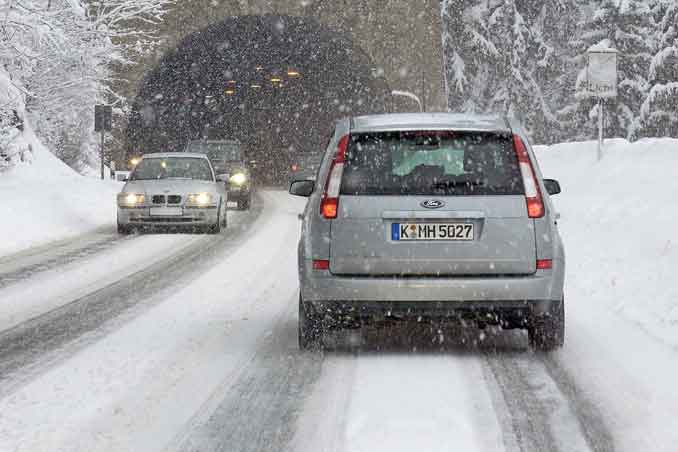Winter weather is all about being seen. Worry often enough blenders, one eyed and darkmen (meaning the headlights) for irritation and danger in road traffic. Tip: The nationwide free “light test” in October, for example, provides the necessary security.
There is also a risk of disruption due to the weather: Drivers must expect fog, freezing rain and snow at all times – this applies above all to trips to the low mountain ranges and the Alps, where no one should travel without winter equipment.
When beginning of winter applies the December 1 until 28/29 February and always lasts three months. Then spring begins. There are numerous traffic jams during the winter holidays. To plan, you can query the exact vacation times in the calendar.
That’s how you take care

- View: Thorough cleaning of the windscreen, both inside and out, is also part of good visibility, and not just in smokers’ vehicles. The same applies to the visors of motorcycle helmets, because when light rays hit dirty glass or grease residue on the surfaces, they are refracted more and increase the glare effect.Coatings on the glass impair the view, allow the panes to fog up more easily and promote dangerous reflections when there is backlight. Appropriate wipe water additives are commercially available. They prevent streaking. If the wiper blades leave streaks or do not clean properly, they should definitely be replaced.
- Antifreeze: The windscreen/headlight washer now needs winter cleaner to keep it from freezing. The cooling system also relies on antifreeze to prevent the engine from collapsing below zero degrees. The door seals do not freeze if you keep them elastic with a rubber care stick. That’s cheaper than a torn door seal. In order to prevent the windshield washer system and the engine cooling system from collapsing when the temperature is below zero, drivers must ensure adequate antifreeze. The additives contained in modern engine coolants prevent the formation of rust and limescale deposits. Regular checking of the fill level in a specialist workshop is therefore important. If you prefer the do-it-yourself method, you should definitely follow a few rules: With the help of a small suction pump, the so-called spindle from the specialist shop or hardware store, drain some liquid from the expansion tank. The scale now shows the sub-zero temperatures down to which the engine is protected. It is essential to wait until the engine has cooled down before checking. Otherwise there is a risk of scalding as the system is under pressure.
- If the spindle scale reads less than minus 25 degrees Celsius, add antifreeze. The level should be between the minimum and maximum marks. “When choosing the antifreeze – as with motor oils – the approvals and regulations of the car manufacturers must be observed,” emphasizes Sander. A look at the operating instructions will help here.
- A sufficient amount of alcohol-based antifreeze must be present in the windscreen washer fluid. There are either ready-mixes or concentrates, which should be diluted with water according to the instructions – otherwise they can attack rubber seals, for example.
- Battery: The number one weak point in the cold is the car battery, which suffers thousands of breakdowns every winter. The capacity of the battery drops to around half at minus 20°C. Therefore: Have the battery checked before winter to see if it will last another season. If you do need a new one, follow our battery guide.
- Tires: Winter tires need a profile of at least 4 millimeters to ensure good grip on slippery roads, recommends Krügel. Winter tires lose their elasticity over the years and should therefore not be older than six years. “Whether changing or buying a new one: don’t wait until the first snow. Skids, waiting times and delivery bottlenecks are then often unavoidable,” says the expert.
- Snow chains: It is advisable to have snow chains on board when driving in mountainous regions. They must match the tire size and belong on the drive axle in two-wheel drive vehicles and on the steered wheels in four-wheel drive vehicles. DEKRA recommends practicing the installation at home in a dry garage. “Assembly in the snow is an annoyance enough,” says Krügel.
- Accesories: In the cold season, ice scrapers, hand brooms, windscreen antifreeze, gloves and a film for the windscreen belong in the car. Because longer traffic jams can occur more quickly in winter, a blanket, drinking water and emergency provisions should also be on board, especially on longer journeys.
- Winter check: If you don’t want to lend a hand yourself: workshops, testing organizations or automobile clubs offer professional winter checks in autumn, which examine the car from all angles.
Danger of rusting due to road salt
Now wash the car thoroughly. The wintry road conditions of the last few weeks with ice and snow have also affected our cars. This applies in particular to road salt. That is why the Automobile Club Motorists Protection (KS) advises to have the car washed thoroughly now. Because the salt on the roads promotes the formation of rust. The salty condensation whirled up by the wheels reaches the paintwork, the inside of the fenders and the underbody, and it offers an ideal breeding ground for corrosion.
Although the car can be dirty again after just a few kilometers, the KS advises having it washed, because the cleaning is less about beauty and more about rust protection. A thorough car wash delays the formation of rust considerably. If the car is additionally treated with hot wax, the rust prevention is almost complete. It is best to drive the car into the car wash when the thermometer shows plus degrees.
Grab your sunglasses even in winter
In winter, the sun’s rays, which strike at a flat angle, dazzle road users considerably. The risk of accidents increases rapidly because poor visibility impairs the ability to react. If a journey cannot be continued safely due to extremely adverse visibility conditions, TÜV Rheinland recommends pulling over to the right as soon as possible and taking a break. This is especially true if you have accidentally looked directly at the sun and are almost blind for a short time. The eyes need a few minutes to regenerate.
The best protection against radiation is good sunglasses, even in winter. It should always be within reach in the vehicle. Particularly important: If visibility is poor, a sufficient safety distance should generally be maintained, the speed should be slowed down and you should drive with foresight. TÜV Rheinland calculates that anyone who is blinded for just one second at 50 km/h is flying blind about 14 meters.
The winter weather makes for dangerous roads
- Fog
- Freezing wetness
- Snow
- Bad sight
- Stressed drivers and traffic jams
Take precautions in winter weather
- Check lighting system and fog light
- The battery
- Change the tires before the first snowfall
Anyone who drives in Germany in wintry road conditions without winter or all-season tires risks a fine of 60 euros and a point in Flensburg. If drivers impede or endanger traffic in a specific case, 80 euros and one point are due.
Drive with foresight
In addition to the necessary accessories, a careful, anticipatory driving style is always the order of the day. That means: alertness up, speed down – especially on bridges or shady sections of road, as icy surfaces are particularly stubborn here. Abrupt braking and steering maneuvers must be avoided at all costs, otherwise the car can quickly skid on unstable surfaces.
Clear view
Seeing and being seen is especially important now in the dark season. If you can hardly see through the windshield and the wipers just clear their wiping field, then you should stop for a moment and allow the headlights to look through again. Once around the car and also free the rear lights and the license plate. A hand brush works well for this. But please always stow it behind the driver’s seat. Never before! Otherwise it can slip under the pedals when braking.
If you want to save yourself the hassle of scraping free, you can rely on an auxiliary heater. The white splendor must also be completely removed from the roof, otherwise it can quickly slide forward and obstruct the view. In bad weather conditions, be sure to turn on the lights even during the day. Equipped in this way, motorists can also enjoy winter.

